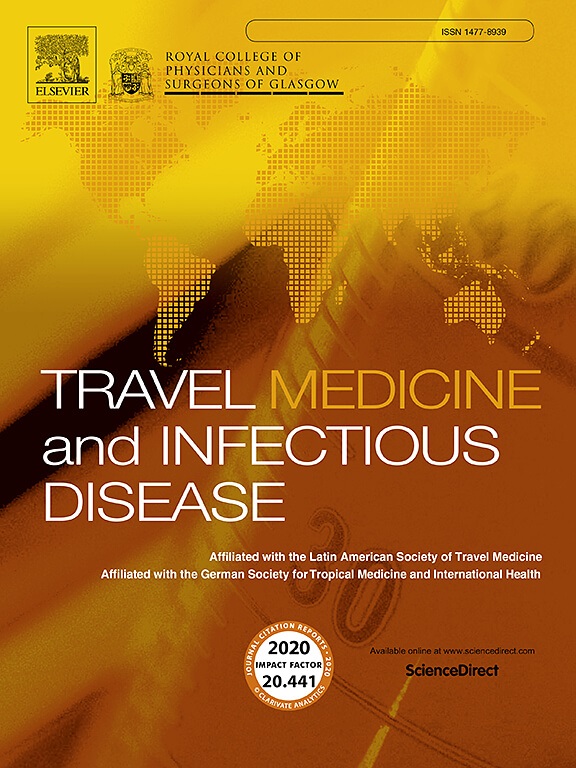Preliminary screening of ESBL-producing Escherichia coli and Klebsiella pneumoniae carriage among migrant communities in Klang Valley, Malaysia
IF 4.7
3区 医学
Q1 INFECTIOUS DISEASES
引用次数: 0
Abstract
Economic migrant workers are crucial for a country's development but may also contribute to transboundary transmission of antimicrobial resistance (AMR). This study aimed to investigate the silent carriage of ESBL-producing Escherichia coli (ESBLEC) and Klebsiella pneumoniae (ESBLKP) among economic migrants from Indonesia, Bangladesh and Nepal residing in Klang Valley, Malaysia. Between December 2023 and May 2024, 263 study participants of Indonesian, Bangladeshi, and Nepalese migrant communities were recruited and rectal swabs collected. Swabs were then cultured on CHROMagar™ ESBL; presumptive ESBL-positive strains were confirmed and antimicrobial susceptibility-tested using a VITEK 2 system. ESBL genotyping was also performed on confirmed isolates. A total of 67 and five strains were confirmed as ESBLEC and ESBLKP, respectively. Both ESBLEC and ESBLKP strains showed similar resistance to penicillin and 3rd generation cephalosporins, though more ESBLKP strains were resistant to 4th generation cephalosporins. More ESBLEC strains were resistant to ciprofloxacin. No carbapenem-resistant strains were detected. The blaCTX-M-1 gene family was predominantly found in ESBLEC strains from all three nationalities, while ESBLKP strains frequently harboured blaTEM, blaCTX-M, and blaSHV genes. The prevalence of ESBL-producing strains was highest among Bangladeshi participants (n = 16, 31.4 %), followed by Indonesians (n = 47, 29.7 %) and Nepalis (n = 9, 19.1 %) working in domestic or manufacturing sectors. These findings highlight the public health risks of high ESBLEC and ESBLKP carriage in healthy migrant workers, which may impact recruitment and retention, leading to labour shortages and higher costs. Screening and increased awareness are crucial to limit the spread of these pathogens.
马来西亚巴生谷移民社区产esbl大肠杆菌和肺炎克雷伯菌携带的初步筛选
经济移徙工人对一个国家的发展至关重要,但也可能促进抗微生物药物耐药性的跨界传播。本研究旨在调查居住在马来西亚巴生谷的来自印度尼西亚、孟加拉国和尼泊尔的经济移民中产esblc大肠杆菌(ESBLEC)和肺炎克雷伯菌(ESBLKP)的无声携带情况。在2023年12月至2024年5月期间,研究人员招募了263名来自印度尼西亚、孟加拉国和尼泊尔移民社区的研究参与者,并收集了直肠拭子。然后在CHROMagar™ESBL上培养拭子;用VITEK 2系统对推定的eslb阳性菌株进行确认和抗菌药物敏感性测试。对确认的分离株也进行了ESBL基因分型。ESBLEC和ESBLKP分别鉴定为67株和5株。ESBLEC和ESBLKP菌株对青霉素和第3代头孢菌素耐药相似,但ESBLKP菌株对第4代头孢菌素耐药较多。更多的ESBLEC菌株对环丙沙星耐药。未检出碳青霉烯耐药菌株。blaCTX-M-1基因家族主要存在于三个民族的ESBLEC菌株中,而ESBLKP菌株经常含有blactem、blaCTX-M和blaSHV基因。产esbl菌株的流行率在孟加拉国参与者中最高(n = 16, 31.4%),其次是印度尼西亚人(n = 47, 29.7%)和在国内或制造业工作的尼泊尔人(n = 9, 19.1%)。这些研究结果突出了健康移徙工人中ESBLEC和ESBLKP高携带的公共卫生风险,这可能影响招聘和保留,导致劳动力短缺和更高的成本。筛查和提高认识对于限制这些病原体的传播至关重要。
本文章由计算机程序翻译,如有差异,请以英文原文为准。
求助全文
约1分钟内获得全文
求助全文
来源期刊

Travel Medicine and Infectious Disease
PUBLIC, ENVIRONMENTAL & OCCUPATIONAL HEALTH-INFECTIOUS DISEASES
CiteScore
19.40
自引率
1.70%
发文量
211
审稿时长
49 days
期刊介绍:
Travel Medicine and Infectious Disease
Publication Scope:
Publishes original papers, reviews, and consensus papers
Primary theme: infectious disease in the context of travel medicine
Focus Areas:
Epidemiology and surveillance of travel-related illness
Prevention and treatment of travel-associated infections
Malaria prevention and treatment
Travellers' diarrhoea
Infections associated with mass gatherings
Migration-related infections
Vaccines and vaccine-preventable disease
Global policy/regulations for disease prevention and control
Practical clinical issues for travel and tropical medicine practitioners
Coverage:
Addresses areas of controversy and debate in travel medicine
Aims to inform guidelines and policy pertinent to travel medicine and the prevention of infectious disease
Publication Features:
Offers a fast peer-review process
Provides early online publication of accepted manuscripts
Aims to publish cutting-edge papers
 求助内容:
求助内容: 应助结果提醒方式:
应助结果提醒方式:


